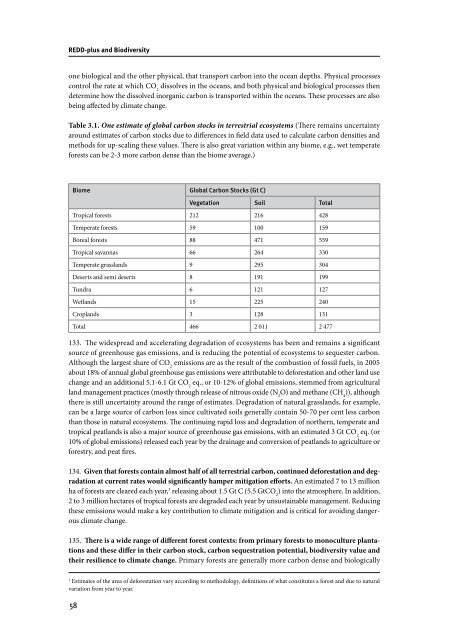REDD-plus and Biodiversity - Convention on Biological Diversity
REDD-plus and Biodiversity - Convention on Biological Diversity
REDD-plus and Biodiversity - Convention on Biological Diversity
Create successful ePaper yourself
Turn your PDF publications into a flip-book with our unique Google optimized e-Paper software.
<str<strong>on</strong>g>REDD</str<strong>on</strong>g>-<str<strong>on</strong>g>plus</str<strong>on</strong>g> <str<strong>on</strong>g>and</str<strong>on</strong>g> <str<strong>on</strong>g>Biodiversity</str<strong>on</strong>g><br />
<strong>on</strong>e biological <str<strong>on</strong>g>and</str<strong>on</strong>g> the other physical, that transport carb<strong>on</strong> into the ocean depths. Physical processes<br />
c<strong>on</strong>trol the rate at which CO 2<br />
dissolves in the oceans, <str<strong>on</strong>g>and</str<strong>on</strong>g> both physical <str<strong>on</strong>g>and</str<strong>on</strong>g> biological processes then<br />
determine how the dissolved inorganic carb<strong>on</strong> is transported within the oceans. These processes are also<br />
being affected by climate change.<br />
Table 3.1. One estimate of global carb<strong>on</strong> stocks in terrestrial ecosystems (There remains uncertainty<br />
around estimates of carb<strong>on</strong> stocks due to differences in field data used to calculate carb<strong>on</strong> densities <str<strong>on</strong>g>and</str<strong>on</strong>g><br />
methods for up-scaling these values. There is also great variati<strong>on</strong> within any biome, e.g., wet temperate<br />
forests can be 2-3 more carb<strong>on</strong> dense than the biome average.)<br />
Biome Global Carb<strong>on</strong> Stocks (Gt C)<br />
Vegetati<strong>on</strong> Soil Total<br />
Tropical forests 212 216 428<br />
Temperate forests 59 100 159<br />
Boreal forests 88 471 559<br />
Tropical savannas 66 264 330<br />
Temperate grassl<str<strong>on</strong>g>and</str<strong>on</strong>g>s 9 295 304<br />
Deserts <str<strong>on</strong>g>and</str<strong>on</strong>g> semi deserts 8 191 199<br />
Tundra 6 121 127<br />
Wetl<str<strong>on</strong>g>and</str<strong>on</strong>g>s 15 225 240<br />
Cropl<str<strong>on</strong>g>and</str<strong>on</strong>g>s 3 128 131<br />
Total 466 2 011 2 477<br />
133. The widespread <str<strong>on</strong>g>and</str<strong>on</strong>g> accelerating degradati<strong>on</strong> of ecosystems has been <str<strong>on</strong>g>and</str<strong>on</strong>g> remains a significant<br />
source of greenhouse gas emissi<strong>on</strong>s, <str<strong>on</strong>g>and</str<strong>on</strong>g> is reducing the potential of ecosystems to sequester carb<strong>on</strong>.<br />
Although the largest share of CO 2<br />
emissi<strong>on</strong>s are as the result of the combusti<strong>on</strong> of fossil fuels, in 2005<br />
about 18% of annual global greenhouse gas emissi<strong>on</strong>s were attributable to deforestati<strong>on</strong> <str<strong>on</strong>g>and</str<strong>on</strong>g> other l<str<strong>on</strong>g>and</str<strong>on</strong>g> use<br />
change <str<strong>on</strong>g>and</str<strong>on</strong>g> an additi<strong>on</strong>al 5.1-6.1 Gt CO 2<br />
eq., or 10-12% of global emissi<strong>on</strong>s, stemmed from agricultural<br />
l<str<strong>on</strong>g>and</str<strong>on</strong>g> management practices (mostly through release of nitrous oxide (N 2<br />
O) <str<strong>on</strong>g>and</str<strong>on</strong>g> methane (CH 4<br />
)), although<br />
there is still uncertainty around the range of estimates. Degradati<strong>on</strong> of natural grassl<str<strong>on</strong>g>and</str<strong>on</strong>g>s, for example,<br />
can be a large source of carb<strong>on</strong> loss since cultivated soils generally c<strong>on</strong>tain 50-70 per cent less carb<strong>on</strong><br />
than those in natural ecosystems. The c<strong>on</strong>tinuing rapid loss <str<strong>on</strong>g>and</str<strong>on</strong>g> degradati<strong>on</strong> of northern, temperate <str<strong>on</strong>g>and</str<strong>on</strong>g><br />
tropical peatl<str<strong>on</strong>g>and</str<strong>on</strong>g>s is also a major source of greenhouse gas emissi<strong>on</strong>s, with an estimated 3 Gt CO 2<br />
eq. (or<br />
10% of global emissi<strong>on</strong>s) released each year by the drainage <str<strong>on</strong>g>and</str<strong>on</strong>g> c<strong>on</strong>versi<strong>on</strong> of peatl<str<strong>on</strong>g>and</str<strong>on</strong>g>s to agriculture or<br />
forestry, <str<strong>on</strong>g>and</str<strong>on</strong>g> peat fires.<br />
134. Given that forests c<strong>on</strong>tain almost half of all terrestrial carb<strong>on</strong>, c<strong>on</strong>tinued deforestati<strong>on</strong> <str<strong>on</strong>g>and</str<strong>on</strong>g> degradati<strong>on</strong><br />
at current rates would significantly hamper mitigati<strong>on</strong> efforts. An estimated 7 to 13 milli<strong>on</strong><br />
ha of forests are cleared each year, 3 releasing about 1.5 Gt C (5.5 GtCO 2<br />
) into the atmosphere. In additi<strong>on</strong>,<br />
2 to 3 milli<strong>on</strong> hectares of tropical forests are degraded each year by unsustainable management. Reducing<br />
these emissi<strong>on</strong>s would make a key c<strong>on</strong>tributi<strong>on</strong> to climate mitigati<strong>on</strong> <str<strong>on</strong>g>and</str<strong>on</strong>g> is critical for avoiding dangerous<br />
climate change.<br />
135. There is a wide range of different forest c<strong>on</strong>texts: from primary forests to m<strong>on</strong>oculture plantati<strong>on</strong>s<br />
<str<strong>on</strong>g>and</str<strong>on</strong>g> these differ in their carb<strong>on</strong> stock, carb<strong>on</strong> sequestrati<strong>on</strong> potential, biodiversity value <str<strong>on</strong>g>and</str<strong>on</strong>g><br />
their resilience to climate change. Primary forests are generally more carb<strong>on</strong> dense <str<strong>on</strong>g>and</str<strong>on</strong>g> biologically<br />
3<br />
Estimates of the area of deforestati<strong>on</strong> vary according to methodology, definiti<strong>on</strong>s of what c<strong>on</strong>stitutes a forest <str<strong>on</strong>g>and</str<strong>on</strong>g> due to natural<br />
variati<strong>on</strong> from year to year.<br />
58

















